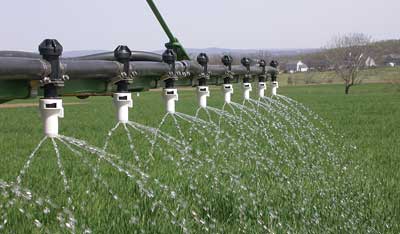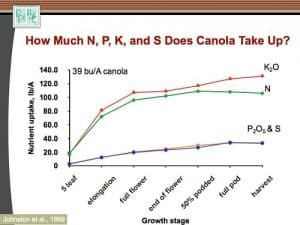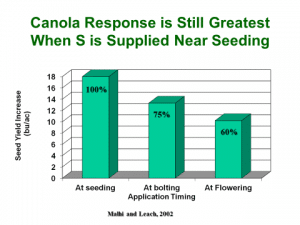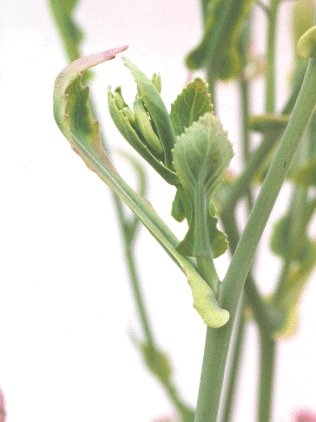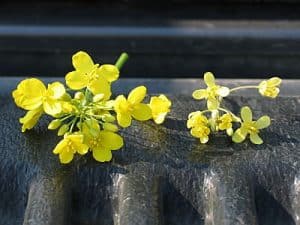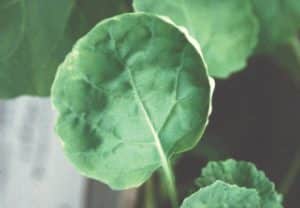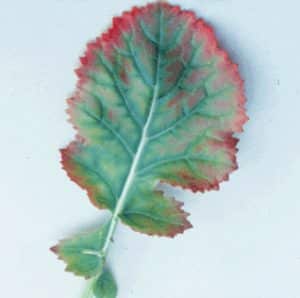Western Canada has a short growing season. Crops in Western Canada start to take up nutrients early and uptake escalates quickly. For these reasons, the ideal timing for fertilizer application is at seeding. This saves an extra pass over the field and ensures that the expected fertilizer requirement is in place when the crop needs it. But in-season application of nitrogen or sulphur can make sense in some circumstances.
Nitrogen
A nitrogen top dress can make financial sense for canola if:
- Growing conditions improve after seeding. If conditions were too wet or too dry at the time of seeding, growers may have cut back fertilizer rates in response to lower yield projections. If conditions improve in June and a good stand emerges, growers may see a yield benefit from a nitrogen top up. In dry conditions, applying approximately two thirds of the recommended nitrogen rate at seeding then topping up with the remaining one third if conditions improve has shown to be an effective and economical practice.
- Saturated soils impede good seed placement. This expands on the previous point. When the only choices to get canola seeded are mudding in or broadcast, cutting back nitrogen rates at seeding may be a good risk management practice. Handling less fertilizer at seeding may help facilitate better seed placement. It may also put a smaller proportion of the fertilizer at risk for significant nutrient losses and allow assessment of stand establishment and crop potential before applying the balance of the fertilizer. If the crop becomes well established, an investment in more nitrogen fertilizer would be warranted.
- High nitrogen losses have occurred. Wet soil conditions can accelerate nitrogen losses through leaching and denitrification. Fields may need a nitrogen top up to reach their yield potential, but make sure canola survived the wet conditions before investing in a fertilizer top up. Note: In general, permanent nitrogen losses due to volatilization, denitrification and leaching are quite low for nitrogen banded at the time of seeding on Prairie soils. (See the graph below showing how rainfall can move nitrogen lower in the soil profile.)
- The crop is showing signs of nitrogen deficiency. Nitrogen deficiency symptoms first show up in older leaves as pale green to yellow coloring, and sometimes purpling. Tissue analysis can confirm these observations, but tissue analysis is not an exact science. Sampling error can be a problem. Many labs offer tissue samples, so check with the lab for proper sampling procedures. A comparative tissue test where samples are taken from both healthy and poor areas in a field is useful for determining the cause of nutrient deficiencies. Turn around time is another hurdle. Growers should sample as early as possible to get results in time to take action.
- A grower cannot efficiently place all the fertilizer needed through the seeding tool. Some growers will address this with a top dress application of nitrogen after crop emergence. Nitrogen applied to the soil surface is at risk of losses (volatilization), so these applications are best timed with a rain to move the nitrogen into the soil. A urease inhibitor can be used to help reduce these losses. If time and logistics are factors, hiring someone to broadcast nitrogen just before seeding may be the preferred over an in-crop top dress.
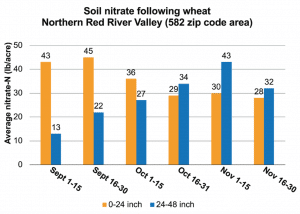
When to apply
The earlier the better, and before the 4- to 6-leaf stage of the crop. This is pre-bolting stage just before buds form and plants begin to elongate. For canola, maximum rates of nitrogen uptake occur from about the 5-leaf stage to full bloom. (See the graph.) Ideally, nitrogen should be applied before that period because rainfall is required to move the fertilizer into the root zone and make it available for uptake.
AAFC research out of Indian Head, Saskatchewan, showed that nitrogen top dress as late as 5-10% flower can still provide a yield benefit. The benefit may not be as high as an earlier application, but could still be economical. If a field is close to flowering and plants have pale lower leaves and stunted growth that could be attributed to nitrogen deficiency, then a top up may pay off. To determine the likelihood of deficiency, think about the rates put down, possible losses due to high soil moisture levels, and yield outlook for the crop. (Find more on deficiency symptoms in the Canola Encyclopedia chapter on nitrogen.) When making this assessment, consider the possibility that excess soil has stressed roots and inhibited nutrient uptake. In this case, a top up may not provide any benefit if the deficiency is due to inability to access the nutrient rather than insufficient quantities in the soil.
What nitrogen source to use
Nitrogen options for in crop application are urea (dry), UAN (liquid) or ammonium sulphate (if sulphur shortages are also expected.)
UAN, being comprised of half ammonium nitrate, is slightly less prone to losses than dry urea broadcast on the surface, but both surface applications require rain (ideally 15mm or more) soon after application to move the fertilizer into the soil and limit volatilization losses. The key for UAN is that it reach the soil surface. UAN applied in no-till situations with high trash cover can be absorbed by the residue. This fertilizer is not lost, but may not be entirely available to the current crop. Top-dressed nitrogen immobilized in high-residue fields may serve to promote mineralization cycling in lower layers of residue, so while the applied nitrogen may not be available, it helps to increase the available pool.
Products such as Agrotain (a urease inhibitor) or SuperU (urease inhibitor + nitrification inhibitor) will reduce volatilization losses for surface applied nitrogen. It will not reduce immobilization losses. Nitrogen that has been stabilized with nitrification inhibitors such as SuperU, eNtrench or N-Serve will not move much in the soil, even under saturated conditions.
Ammonium sulphate is less volatile than urea and, in general, will not lose nitrogen as quickly when surface applied. However, losses from ammonium sulphate can be higher in calcareous soils. Ammonium sulphate reacts with the calcium carbonate (CaCO3), and releases free ammonia that is subject to volatilization.
ESN is not recommended for post seeding applications because its slow-release feature may not release the nitrogen in time to produce an economical crop yield response. Plus, it works best when buried in the soil.
If using granular, apply when leaves are dry to make sure prills roll off onto the ground and don’t cause leaf burn.
If using liquid, try to apply when leaves are moist from early dew or a light rain so liquid nitrogen fertilizer runs off quickly. Applying when hot and dry can increase absorption of liquid into the plant, increasing the amount of leaf burn. Consider adding some extra water to the tank in these conditions if waiting is not an option.
NOTE: Plants hit by liquid nitrogen fertilizer will be burned and stressed. Spraying them with a herbicide right afterward can kill or set back these stressed plants. Give the crop a few days to recover before making any other applications.
How much to apply
At least 20 per cent of the target nitrogen rate is recommended. For example, if the goal is to apply 100 lb./ac. of actual nitrogen, the top dress should be at least 20 lb./ac. and probably 30-40 lb./ac. to make it meaningful. Remember, a nitrogen top up will extend canola’s vegetative period and delay maturity. Consider the calendar date and fall frost risk in addition to potential yield benefits when making a nitrogen top up decision.
Growers may need to top dress up to 30 lb./ac. of actual nitrogen to see a noticeable improvement with the naked eye, but yield differences for rates lower than that may show up at harvest.
Application technique
Broadcast spreading of urea or surface dribble banding of UAN are the most common and fastest methods. Click here for more on equipment options. But these methods can also result in the highest volatilization losses if rain doesn’t come quickly. (Losses with UAN, which is half ammonium nitrate, tend to be lower than with urea.) The urease inhibitor NBPT helps to minimize these losses. Read “Factors for loss” below.
Fertilizer placement in the soil, as opposed to on the surface, greatly minimizes losses from volatilization and immobilization, and enhances overall nitrogen fertilizer recovery. This may be difficult to achieve in practice because older spoke wheel applicators are not very common. Side dressing requires much more technologically advanced equipment to band the nitrogen in the soil while the crop is growing rather than leaving it on the surface.
Tank mixing liquid nitrogen with herbicide and applying through the sprayer is not recommended for a few reasons. This method can provide only a few pounds of actual nitrogen per acre — which isn’t enough to make a difference. Leaf (foliar) applications are highly inefficient, as plants take up nutrients through their roots. (The expression “One pound through the leaf is worth 10 pounds through the soil” is not true logically. If it were, you could produce a 50-bushel canola crop on 10 pounds of N through the leaf, which is highly unlikely.) Finally, fertilizer blanket applied over the leaves through flat-fan nozzles can damage the crop.
A variable rate applicator using GreenSeeker is a hig-tech option. GreenSeeker uses an electric eye to estimate crop biomass, yield potential and crop nutrient requirements. The sensors can be attached to a nitrogen applicator and provide continuous and instantaneous readings for variable rate applications.
“Spoon-feeding” Nitrogen. Using many small applications through the uptake period is routine in potatoes (it is called fertigation), but this not economically efficient for canola in Western Canada. That’s because (1) multiple applications add to the cost, (2) nitrogen applied into the soil early in the season is generally most efficient and in-place as the crop needs it, and (3) weather variability through the season add to the risk that the job won’t get done. An exception is if N losses have been high (or the crop under-fertilized). In those cases, in-crop applications may be warranted.
As Manitoba Agriculture fertility specialist John Heard says, multiple in-season fertilizer applications can work for a long-season crop like corn if you have irrigation when it is dry and tile drainage for when it is wet. “There is simply not enough opportunities to intervene in a crop like canola or cereals,” he says. He adds that in corn, in-crop applications are banded into the soil between the rows. They are not top-applied with a sprayer.
Factors for loss
The following will influence the amount of loss for surface-applied N.
- Soil pH. The increase in N volatilization over time can be roughly two times higher for soil at pH of 7.5 versus soil at pH of 6.5.
- Surface wetness. If the soil surface is bone dry, there are no losses. High relative humidity (80% or more) can lead to losses even if it hasn’t rained in the past few days because moisture in the air can be enough to cause hydrolysis. A light 0.10″ rain may increase loss because it does not move urea deep enough into soil, but half an inch of rain within two days will limit losses to almost zero. If surface is moist then turns dry rapidly, losses can be high initially, but cease when soils become dry.
- Wind conditions. Winds that dry out the surface area can increase losses. Wind also contributes to the volatilization potential by reducing the concentration of volatilized nitrogen (ammonia) at the soil surface, thus increasing the rate of volatilization.
- Crop residues. Surface residues can limit fertilizer-to-soil contact, and the fertilizer can be hung up in the straw and immobilized. Residues also have high levels of the urease enzyme that promotes volatilization.
- Soil texture. Sandy soils tend to have higher losses.
- Broadcast vs band. Losses will be lower when N is in a concentrated band.
Questions and answers
Question: What are the typical equipment and nutrient source options for an in-crop application?
Answer: This can vary depending on what is available. It could be anything from a spin spreader to a floater or a sprayer with liquid fertilizer nozzles if liquid is the fertilizer used. An important thing would be evenness of application, which can be difficult with some of the old spin spreaders. As for sources, urea, Super U and UAN are common. Products such as Super U and Agrotain-treated urea can protect nitrogen from loss. UAN alone is less prone to losses than straight urea, but both can see substantial losses from surface applications.
Question: When is the correct time to apply more nitrogen to a canola crop?
Answer: Timing can be any point up until the six-leaf stage for nitrogen (and up until early flower at the latest for sulphur). Top dressing can be effective anytime from seeding to the six-leaf stage. Lots of people will target the two- to three-leaf stage as there is still lots of bare ground to hit (with liquid applications), which is the intended target. UAN will burn leaf material if it comes in contact, but this is generally superficial and is not something to worry about. Canola starts to use a lot of nitrogen per day as it reaches the bolting stage, so the nitrogen needs to be applied early enough that it moves into the root zone by the time the plant needs it. Another important aspect to consider is rainfall. Nitrogen needs ½” of rain following application to move it into the root zone. Rainfall amounts less than this can lead to more losses as the fertilizer starts to convert on the soil surface and is volatilized rather than “washed” into the soil. If the topdressing application can be made one or two days prior to a rainfall that is ideal. Since it is so hard to rely on forecasts, protection offered by an enhanced efficiency nitrogen source can help. Another consideration is time given that this is also weed spraying season.
Question: What is the typical split in application? (Ex. 70 per cent applied through the drill and 30 per cent as in-field top dress)
Answer: That will vary from farm to farm. In a dry spring, people may want to apply a slightly reduced amount up front because of the dryness, then top up if conditions improve. In that scenario, apply the amount up front that meets the yield target based on conditions at the time. If the yield target improves because of the environment, then top up with the amount needed to reach the new yield target. If the goal with a split application is to increase the efficiency of seeding, try 60 to 70 per cent at seeding. This provides adequate amounts for early growth and, if the in-field top dress is timed correctly, it will not impact yield.
Question: What fits 4R better, split application or 100 per cent through the drill?
Answer: Both options can fit within 4R. With 100 per cent banded through the drill, this achieves the best placement for fertilizer and you know it will be there when the plant needs it. For right time, top-dressing is 4R compliant. An enhanced efficiency nitrogen source is not prone to excessive losses when top dressing.
More…
- Manitoba Agriculture factsheet: Volatilization losses from surface-applied nitrogen
- More on equipment for top-dressing fertilizer
- Canola Encyclopedia section on nitrogen fertilizer
- Canola Research Hub research on nitrogen fertilizer
Sulphur
Peak sulphur uptake for canola occurs later than peak nitrogen uptake, so a sulphur top up can occur a little later than nitrogen top up. Post-emergence sulphur can be applied up to early flowering and still provide a yield benefit, however earlier is usually better if the field is deficient.
Research by Malhi and Leach showed that in-crop top-dress or foliar application of sulphate-S as late as early flowering resulted in moderate to substantial increase in seed yield, though seed yield tended to be less than that obtained with application at seeding time. In this study, seed yield was greatest with application at seeding time, followed by application at bolting time and at flowering time, with average increase in seed yield of 17.4, 13.8, and 10.9 bu./ac., respectively. If sulphur deficiencies show up at the flowering stage, evaluate the cause and consider an updated sulphur fertilizer plan for next year.
In the meantime, if an in-crop application is required to rescue yield potential for this year, growers could target only those areas — such as hill tops or areas of lighter soil texture — that tend to be sulphur deficient as long as they knew the rest of the field was OK.
A sulphur top dress can make financial sense for canola if:
- Growers could not put the desired rate on at seeding.
- Yield potential improved and growers want to add sulphur to their nitrogen top up. If field conditions have been excessively moist, sulphur may have moved lower in the soil profile. As canola plants grow, their roots will extend into these reserves. For that reason, growers who have been applying recommended rates of sulphur may not see as much economic return from a sulphur top up compared to a grower who has cut sulphur rates in recent years.
- Canola shows signs of sulphur deficiency. With sulphur deficiency, yellowing and leaf cupping tend to occur on new leaves first. Purpling of leaf edges can show up when deficiency is fairly severe. (See the photos below.) In fields short of sulphur, crops can usually find enough to get past the early rosette stage without visible symptoms. Deficiency symptoms often show up at flowering. (Scroll to the bottom of this article for more photos of sulphur deficiency symptoms.)
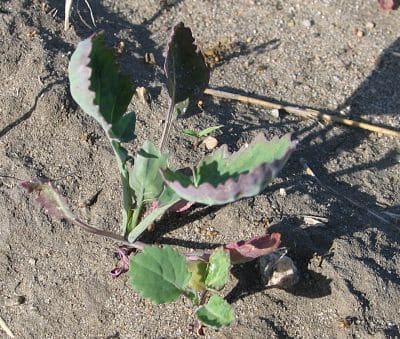
When to apply
The earlier the better, but sulphur can be applied up to early flowering and still provide a yield benefit. Note that response to top-dress applications will depend on receiving enough rainfall after fertilization to move the fertilizer into the root zone. If the crop cannot use all the nutrient applied as a late top dress, most of the S would be available for next year’s crop. The only loss situation would be leaching on a sandy textured soil with lots of rain and snowmelt.
What sulphur source to use
Ammonium sulphate (dry) or ammonium thiosulphate (liquid) provides sulphur that is immediately available to the crop. It also provides a nitrogen top up at the same time.
Elemental sulphur applied at the time of seeding or later will not be available in time for when the crop needs it, especially if it is incorporated. Elemental sulphur prills need time to break apart to increase the surface area, and then require bacteria to oxidize the sulphur into plant available form. While these bacteria are most active in warm moist soils, it can take months for elemental sulphur to become available to the crop.
Also note that any sulphate made available from the oxidation of elemental sulphur applied last fall may have leached down into the soil profile if fields were wet last fall and this spring, potentially delaying availability to the crop this year.
How much to apply
That depends on how much deficiency you expect. As few as 10 to 20 pounds of actual sulphur may be enough to provide an economic benefit, but higher levels may also provide a good return on investment if the soil is very deficient.
Application technique
Application just prior to rainfall is best. Surface applied ammonium sulphate requires rain to move it into the root zone. Sulphur is not volatile like nitrogen fertilizer, so while dry conditions may delay availability to the crop, losses will be minimal if rain is not immediately forecast. Avoid spreading granular product when the leaves are moist from dew to limit sticking of the prills and leaf burn as a result.
If dribble banding liquid ammonium sulphate (8-0-0-9) or ammonium thiosulphate (12-0-0-26), applying when leaf surfaces are wet can allow liquid to run off and limit leaf burn. Leaf burn is expected at any stage of canola development, but any burn damage will cause less economic impact than a nutrient-deficient crop.
Applying sulphate fertilizer in a tank mix with herbicide/fungicide may not provide enough sulphur to provide a benefit to the crop. Also, flat fan sprays that cover the leaf are far more toxic to the crop than fertilizer dribbled on the soil surface. Plus, the crop can’t take up much fertilizer through the leaves.
Factors for loss
If the crop cannot use all the sulphur applied as a late top dress, most of the S would be available for next year’s crop. The only loss situation would be leaching on a sandy textured soil with lots of rain and snowmelt.
Does adding S stabilize N against losses? If the crop also needs sulphur, adding ammonium thiosulphate to the fertilizer blend could provide some (limited) benefit as a nitrification and urease inhibitor. But if stabilization of nitrogen against losses is the true goal, use a known effective stabilizer such as Agrotain or Super U.
Canola Encyclopedia chapter on sulphur
Phosphorus
Phosphorus needs to be in the soil and as close to the seed as possible for maximum benefit. Canola plants continue to take up phosphorus as biomass increases, but phosphorus fertilizer tends to provide its greatest economic benefit very early in the season. As the soil warms up, phosphorus conversion in the soil increases and the crop can tap into existing phosphorus reserves. Unless the soil is very deficient in phosphorus, growers are unlikely to see an economic benefit from an in-crop application.
University of Saskatchewan soil scientist Jeff Schoenau and Masters student Stephen Froese completed a study called “Crop response to foliar-applied phosphorus fertilizers”. They evaluated the response to foliar phosphorus fertilization of canola, pea and wheat grown in Brown, Dark Brown and Black soils in Saskatchewan. While the study did show a yield response for foliar-applied phosphorus when compared to a control without any phosphorus fertilizer, the best practice is still to meet crop needs with fertilizer applications before or at the time of seeding.
Canola Encyclopedia chapter on phosphorus
Sources
(1) “Post Emergent Options for N Fertilization in Western Canada for Wheat and Canola” Guy Lafond, Agriculture and Agri-Food Canada; Stewart Brandt, Agriculture and Agri-Food Canada;, Adrian Johnston, IPNI; and William May, Indian Head Research Farm.
(2) “Using the GreenSeeker to manage nitrogen in canola and wheat.” Lafond et al.
(3) “Improving nutrient use efficiency with enhanced efficiency fertilizers in the Northern Great Plains of North America” Cynthia A. Grant, Agriculture and Agri-Food Canada;, Sukhdev S. Malhi, Agriculture and Agri-Food Canada; and Jeff J. Schoenau, University of Saskatchewan. Published in “Recent Trends in Soil Science and Agronomy Research in the Northern Great Plains of North America, 2010,” ISBN: 978-81-308-0422-4
(4) “Fertilizing Canola and Mustard” NDSU factsheet. D.W. Franzen, NDSU Extension Soils Specialist; J. Lukach, Researcher, Langdon Research Extension Center http://www.ag.ndsu.edu/pubs/plantsci/soilfert/sf1122w.html

